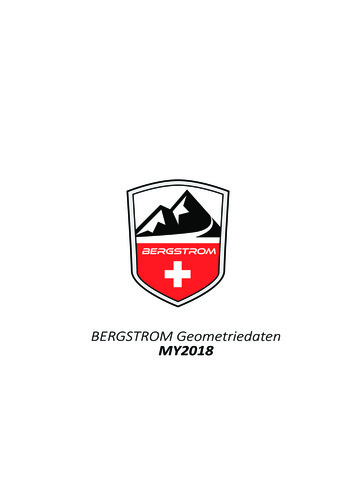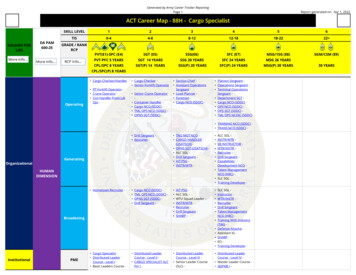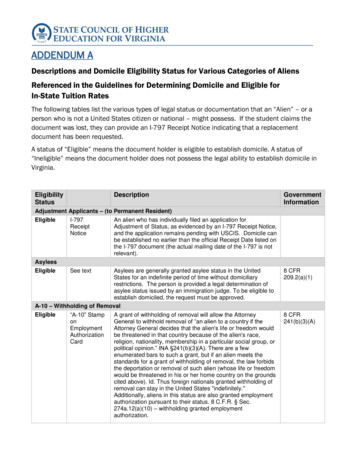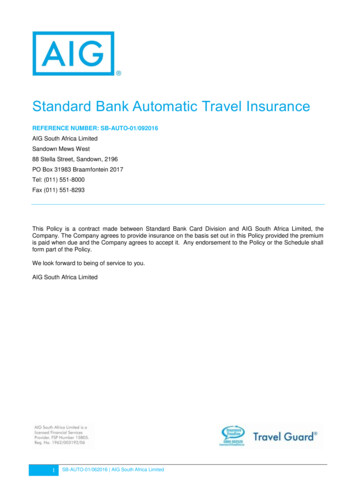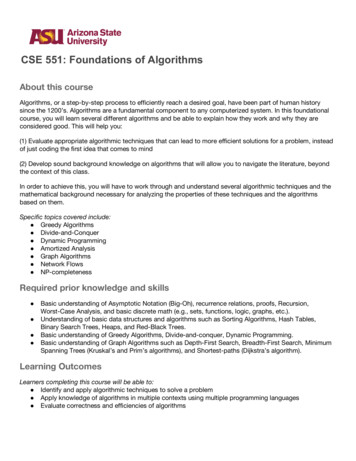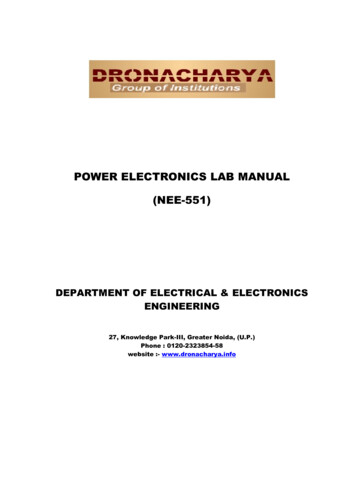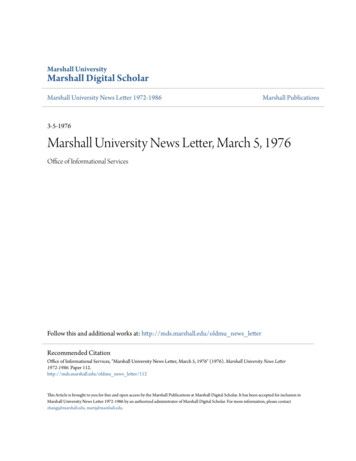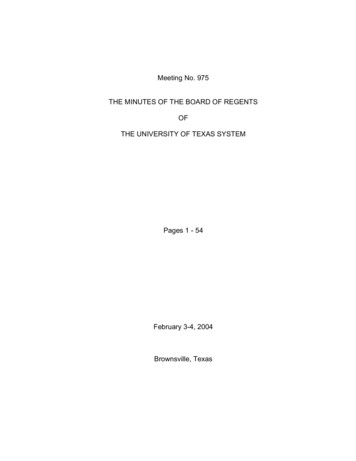
Transcription
Report Date:17 Mar 2020551-88H-1532Operate 5K Light Capacity Rough Terrain Forklift (LCRFT)Status: ApprovedSecurity Classification: U - UnclassifiedDistribution Restriction: Approved for public release; distribution is unlimited.Destruction Notice: NoneForeign Disclosure: FD1 - This training product has been reviewed by the training developers in coordination with the Transportation School Fort Eustis, VA 23608 foreign disclosure officer.This training product can be used to instruct international military students from all approved countries without restrictions.Page 1
Conditions: Assigned as a Rough Terrain Forklift Operator, Soldier must operate 5K Light Capacity Rough Terrain Forklift (LCRFT). Given acompleted risk assessment, all applicable publications, forms, and records, tools, materials, personnel, equipment in all weather conditions day or nightin an operational environment.Some iterations of this task should be performed in MOPP 4.Standards: On orders; Soldier will operate 5K Light Capacity Rough Terrain Forklift (LCRFT) IAW TM 10-3930-680-10, procedures andspecifications utilizing the task Go/No-Go criteria. Comply with all warnings, cautions, and notes listed in all references. Soldier must perform this taskwith 100% compliance, without injury or damage to equipment.Special Conditions:NoneSafety Risk: MediumMOPP 4:SometimesTask StatementsCue: Assigned as a Cargo Checker/Handler, Soldier must operate 5K Light Capacity Rough Terrain Forklift (LCRFT).DANGERAdhere to all DANGER statements listed in the equipment or vehicle technical operator's manual applicable tothis procedure. Failure to comply may result in injury to personnel or damage to equipment.Page 2
WARNINGMODIFICATION HAZARDUnauthorized modifications, alterations or installations of or to this equipment are prohibited and are inviolation of AR 750-10. Any such unauthorized modifications, alterations or installations could result in death,injury or damage to the equipment.HIGH PRESSURE HYDRAULIC SYSTEM HAZARDSHydraulic systems can cause serious injuries if high pressure lines or equipment fail. Never work on hydraulicsystems or equipment unless there is another person nearby who is familiar with the operation and hazards ofthe equipment, and who can give first aid. A second person should stand by controls to turn off hydraulicpumps in an emergency. When the technicians are aided by the operators, the operators must be warnedabout dangerous areas.MOVING MACHINERY HAZARDSBe very careful when operating or working near moving machinery. Running engines, rotating shafts, andother moving machinery parts could cause personal injury or death.ELECTRICAL HAZARDSWhenever possible, the power supply to the equipment must be shut off before beginning work on theequipment. Do not be misled by the term "low voltage."Potentials as low as 50 volts may cause death underadverse conditions”. Be careful not to contact 115-Vac input connections when installing or operating thisequipment. Whenever the nature of the operation permits, keep one hand away from the equipment to reducethe hazard of current flowing through the body.CAUTIONIf this is the first time starting the vehicle, perform PMCS before interval checks. Failure to comply may resultin damage to equipment.Remarks: NoneNotes:NonePage 3
Performance Steps1. Perform pre-operational checks on the 5K Light Capacity Rough Terrain Forkift (LCRTF) in accordance with TM 10-3930-680-10.2. Move battery disconnect switch (Figure 1, Item 1) to ON position.Figure 1Battery Disconnect3. Adjust operator seat (Figure 2, Item 2) so you can press the foot pedals.Note: Parking brake switch must be in the engaged position (down) to start vehicle.Gear selector lever must be in neutral (middle) position to startvehicle.If engine fails to start on first attempt, wait two minutes before attempting to start again.Outside air temperature range for normal starting is 32 F(0 C) to 140 F (60 C).If outside air temperature is between 32 F (0 C) and -25 F (-32 C), See Starting the Engine 32 F (0 C) and -25 F (-32 C). (WP0017)4. Fasten seat belt (Figure 2, Item 1).Page 4
Figure 2Fasten Seat Belt5. Turn the ignition switch (Figure 3, Item 5) clockwise to the IGN/START position. Release the switch as soon as the engine starts. If the engine failsto start on the first try, wait until engine and starter have come to a complete stop. Then, return the switch to the OFF position before attempting to startengine again.a. After engine starts, return accelerator pedal to idle position for approximately 3 minutes. Ensure thatreadings on gauges (Figure 3, Item 6 and 7) are within normal operating ranges.Figure 3Start EnginePage 5
b. Ensure warning lights (Figure 3, Items 1, 2, 3, and 4) are not illuminated before moving vehicle.WARNINGDo not exceed 10 mph (16 kph) when travelling on unimproved surfaces. Failure to comply may result ininjury or death to personnel.6. Move forklift in two-wheel steer mode.WARNINGVehicle is less stable when traveling with load in a raised position. If you must move vehicle with load raisedabove carry position (bottom of load at 24 in. (610 mm) above ground), the following practices should beobserved: Fully retract boom. Forks slightly tilted back (3-5 degrees). Avoid sharp turns and suddenstarts/stops. Operate all controls smoothly. Move very slowly. Keep vehicle level. Use a ground guide.Failure to comply may result in injury or death to personnel.a. Perform complete walk around to ensure wheel chocks have been removed and stored, and that there are no obstacles near vehicle.b. Raise forks so load is approximately 24 in. (610 mm) off ground.WARNINGDo not travel with the Automatic Fork level switch in the ON position. This could cause a load to be dropped.c. Align rear wheels.WARNINGDo not operate with the emergency steer switch OFF. If engine power is lost, there will be a loss ofemergency steering capacity. Failure to follow this procedure could result in injury or death to personnel.d. Set STEER MODE switch (see Figure 4, Item 1) to two-wheel steer mode (down) position. Two-wheel steermode indicator (see Figure 4, Item 2) will illuminate.Page 6
Figure 4Set STEER MODE Switche. Press and hold brake pedal (see Figure 5, Item 4).f. Press parking brake switch (see Figure 5, Item 1) up to release parking brake.WARNING Prior to moving vehicle or operating boom, ensure boom has at least 10 ft (3 m) of clearance from overheadwires, power lines, or structures. If lines are near your operating area, notify your supervisor prior to operatingboom. Failure to comply may result in injury or death to personnel. Keep personnel clear of vehicle whentraveling. Failure to comply may result in injury or death to personnel.CAUTIONPrior to moving vehicle, ensure operator's door window is fully closed or locked in open position. Anunsecured door or window can swing causing glass to break. Failure to comply may result in damage toequipment.g. Press DRIVE/WORK switch (see Figure 5, Item 2) to drive mode (up) position.CAUTIONWhen traveling over rough terrain, reduce travel speed to avoid damage to vehicle or load. Failure to complymay result in damage to equipment.h. Place gear selector lever (see Figure 5, Item 5) in up position to move vehicle (see Figure 5, Item 6) forward.i. Release brake pedal (see Figure 5, Item 4) and slowly press accelerator pedal (see Figure 5, Item 3) to obtaindesired speed.Page 7
Figure 5Release Parking Brake7. Operate forklift in reverse.Note: Reversing direction in vehicle is obtained the same way whether in two-wheel steer mode, four-wheel steer mode, or crab steer mode. Twowheel steer mode shown.a. Release accelerator pedal (see Figure 6, Item 1) and slowly apply brake pedal (see Figure 6, Item 2) until vehicle (see Figure 6, Item 4) comes toa complete stop.b. Move gear selector lever (see Figure 6, Item 3) to reverse (down) position.c. Release brake pedal (see Figure 6, Item 2) and slowly press accelerator pedal (see Figure 6, Item 1) to obtaindesired speed.Page 8
Figure 6Change Direction to Reverse8. Operate forklift to unload/load pallets.a. (Only when loading/unloading containers) Remove carriage backrest weldment.b. Raise forks (see Figure 7, Item 2) enough to clear opening of container (see Figure 7, Item 1).Note: Ensure forks are in the center position prior to entering container.Page 9
Figure 7Unloading Pallet9. Stop forklift.Page 10
Figure 8Stopping Vehiclea. Slowly release pressure on accelerator pedal (see Figure 8, Item 3).b. Slowly apply brake pedal (see Figure 8, Item 4) until vehicle (see Figure 8, Item 6) comes to a complete stop.c. Move gear selector lever (see Figure 8, Item 5) to neutral (middle) position.d. Press parking brake switch (see Figure 8, Item 1) down to apply parking brake.e. Press DRIVE/WORK switch (see Figure 8, Item 2) to work mode (down) position.f. Lower forks flat to ground.10. Stop the engine.a. Turn all lights and accessories off.b. Allow engine to idle for three to five minutes.c. Turn the ignition switch to the OFF position.d. Turn the auxiliary fuel shut-off switch to the OFF position.e. Perform after-operations PMCS.Page 11
f. Lock the steering wheel with the steering wheel locking cable and lock.(Asterisks indicates a leader performance step.)Evaluation Guidance:Score the Soldier a GO if all performance measures are correctly completed/pass (P). Score the Soldier a NO-GO if anyof the performance measures are missed or incorrectly performed/fail (F).Evaluation Preparation:Test this task in with applicable training material. Ensure Soldier understands why this task is important to support theoverall training objective.Setup: Test this task in accordance with prescribed references or Technical Manual (TM).Brief Soldier: Tell the Soldiers adhere to all Safety precautions when performing the task listed.Note: Ensure that all required equipment to perform this task is available.PERFORMANCE MEASURESGONO-GON/A1. Performed pre-operational checks on the 5K LCRTF.2. Moved battery disconnect switch to ON position.3. Adjusted operator seat.4. Fastened seat belt.5. Turned the ignition switch clockwise to the IGN/START position and released the switch as soon as theengine started.6. Moved forklift in two-wheel steer mode.7. Operated forklift in reverse.8. Operated forklift to unload/load pallets.9. Stopped forklift.10. Stopped the engine.Supporting Reference(s):StepNumberReference IDDA FORM 5988-ELO 10-3930-680-13TC 21-305-20TM 10-3930-680-10TADSS :Reference NameEQUIPMENT MAINTENANCE ANDINSPECTION WORKSHEET (EGA)LIGHT CAPABILITY ROUGH TERRAINFORKLIFT (LCRTF) 5KManual for the Wheeled Vehicle Operator{AFMAN 24-306(I)}LIGHT CAPABILITY ROUGHTERRAINFORKLIFT e InformationNoneEquipment Items (LIN):NoneMateriel Items (NSN) :Step IDNSNLINTitleQtyNo materiel items specifiedEnvironment: Environmental protection is not just the law but the right thing to do. It is a continual process and starts with deliberate planning.Always be alert to ways to protect our environment during training and missions. In doing so, you will contribute to the sustainment of our trainingresources while protecting people and the environment from harmful effects. Refer to the current Environmental Considerations manual and the currentGTA Environmental-related Risk Assessment card. It is the responsibility of all Soldiers and DA civilians to protect the environment from damage. AR200-1 delineates TRADOC responsibilities to integrate environmental requirements across Doctrine, Organization, Training, Materiel, Leadership andEducation, Personnel and Facilities (DOTMLPF) and ensure all training procedures; materials and doctrine include sound environmental practices andconsiderations.Page 12
The Army’s environmental vision is to be a national leader in an environmental and natural resource stewardship for present and future generations asan integral part of all Army missions. This Training Support Package meets this standard.Environmental protection is not just the law but the right thing to do. It is a continual process and starts with deliberate planning. Always be alert toways to protect our environment during training and missions. In doing so, you will contribute to the sustainment of our training resources whileprotecting people and the environment from harmful effects. Refer to ATP-45.5 Environmental Considerations and GTA 05-08-002 ENVIRONMENTALRELATED RISK ASSESSMENT.Safety: In a training environment, leaders must perform a risk assessment in accordance with current Risk Management Doctrine. Leaders willcomplete the current Deliberate Risk Assessment Worksheet in accordance with the TRADOC Safety Officer during the planning and completion of eachtask and sub-task by assessing mission, enemy, terrain and weather, troops and support available-time available and civil considerations, (METT-TC).Note: During MOPP training, leaders must ensure personnel are monitored for potential heat injury. Local policies and procedures must be followedduring times of increased heat category in order to avoid heat related injury. Consider the MOPP work/rest cycles and water replacement guidelines IAWcurrent CBRN doctrine. In a training environment, leaders must perform risk management in accordance with ATP 5-19, Risk Management. Leaders willcomplete a DD Form 2977 DELIBERATE RISK ASSESSMENT WORKSHEET during the planning and completion of each task and sub-task byassessing mission, enemy, terrain and weather, troops and support available-time available and civil considerations, (METT-TC), as well as any othervariables.All operations will be performed to protect and preserve Army personnel and property against accidental loss. Procedures will provide for public safetyincidental to Army operations and activities and safe and healthful workplaces, procedures, and equipment. Observe all safety and/or environmentprecautions regarding electricity, cable, and lines. Provide ventilation for exhaust fumes during equipment operation and use hearing protection whenrequired IAW AR 385-10, the Clean Air Act (CAA) and the CAA amendments, and the OSHA Hazard Communication standard.Accidents are an unacceptable impediment to Army missions, readiness, morale, and resources. Decision makers at every level will employ riskmanagement approaches to effectively preclude unacceptable risk to the safety of personnel and property affiliated with this task. (a) Take personalresponsibility. (b) Practice safe operations. (c) Recognize unsafe acts and conditions. (d) Take action to prevent accidents. (e) Report unsafe acts andconditions.No food or drink is allowed near or around electrical equipment (CPU, file servers, printers, projectors, etc.) due to possible electrical shock or damageto equipment. Exercise care in personal movement in and through such areas. Avoid all electrical cords and associated wiring. In event of electricalstorm, you will be instructed to power down equipment.Note: During MOPP training, leaders must ensure personnel are monitored for potential heat injury. Local policies and procedures must be followedduring times of increased heat category in order to avoid heat related injury. Consider the MOPP work/rest cycles and water replacement guidelines IAWATP 3-11.32, NBC Protection, ATP 3-11.32, CBRN Decontamination.Prerequisite Individual Tasks :NoneSupporting Individual Tasks :Task NumberTitleProponentStatus551-88H-1401Perform Preventive Maintenance Checks andServices on Material Handling Equipment551 - Transportation (Individual)ApprovedSupported Individual Tasks :NoneSupported Collective Tasks :NoneKnowledges :Knowledge IDKnowledge 29K409K-551-H-0138K-551-H-0014Knowledge of types of MHEPrior training and knowledge of TM 10-3930-673-10Knowledge of material handling equipmentKnowledge of using hand/arm signalsKnowledge of how to operate the M5K Light Capability Rough Terrain Forklift (LCRTF)Knowledge of PMCS proceduresKnowledge of hand/arm signalsSkills :Skill IDSkill -H-0186Ability to communicate commands by hand and arm signalsAbility to operate the M5K Light Capability Rough Terrain Forklift (LCRTF)Ability to identify and report deficienciesAbility to operate ATLAS Rough Terrain ForkliftAbility to conduct forklift operation and cargo handlingPage 13
S-551-H-0076ICTL Data :Ability to perform preventive maintenance checks and servicesNonePage 14
Report Date: 17 Mar 2020 551-88H-1532 Operate 5K Light Capacity Rough Terrain Forklift (LCRFT) Status: Approved _ Security Classification: U - Unclassified Distribution Restriction: Approved for public release; distribution is unlimited. Destruction Notice: None Foreign Disclosure: FD1 - This training product has been reviewed by the training developers in coordination with the .

